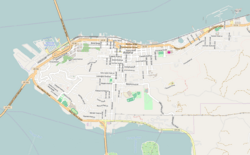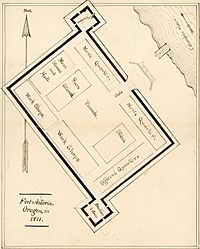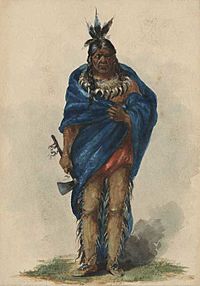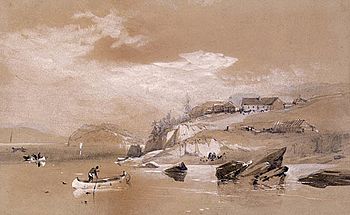Fort Astoria facts for kids
Quick facts for kids Fort Astoria |
|
|---|---|

The trading post as it was in 1813.
|
|
| Type | Fur Trade Post |
| Location | Astoria, Oregon |
| Constructed | 1811 |
| Built for | Pacific Fur Company |
| Abandoned | Unknown |
| Owner |
|
|
Fort Astoria
|
|
|
U.S. Historic district
Contributing property |
|
| Location | Astoria, Oregon |
| Built | 1811 |
| Part of | Astoria Downtown Historic District (ID98000631) |
| NRHP reference No. | 66000639 |
| Significant dates | |
| Added to NRHP | October 15, 1966 |
| Designated NHL | November 5, 1961 |
Fort Astoria (also called Fort George) was a very important place for trading animal furs. It was built by John Jacob Astor's company, the Pacific Fur Company (PFC). Some people from the company sailed there on a ship called the Tonquin. Another group traveled by land from St. Louis, and this journey became known as the Astor Expedition.
Fort Astoria was built in 1811 at the mouth of the Columbia River. It was the first settlement owned by Americans on the Pacific coast of North America. Many different people lived and worked at the fort. They came from places like Scotland, France (French-Canadians), America, and Hawaii. There were also many Indigenous people from different groups, including the Iroquois. Life at the fort could be quite boring, and the food, mostly fish and vegetables, was not very exciting for everyone. The main furs traded here were from beavers, sea otters, squirrels, and red foxes.
When the War of 1812 started, the Pacific Fur Company had to close down. The fort was too far away to get help or protection from the United States. In 1813, a Canadian company called the North West Company (NWC) bought Fort Astoria. They changed its name to Fort George. It became their main base for trading furs in the western part of North America, especially along the Columbia River. Later, in 1821, the Hudson's Bay Company took over the North West Company, and Fort George became part of their trading network.
In 1825, the Hudson's Bay Company built a new, better headquarters called Fort Vancouver. They left Fort George for a while. But when American ships started coming to the Columbia River, the Hudson's Bay Company reopened Fort George to keep an eye on them. The competition over Fort Astoria was a big reason why Britain and America finally settled their arguments about who owned the Oregon Country. Today, the Fort Astoria Site is a National Historic Landmark. It has a rebuilt blockhouse to show where the old fort stood.
Contents
Building Fort Astoria: A Big Challenge
Building Fort Astoria was very difficult. The people who worked for the Pacific Fur Company started building it in May 1811. They used logs covered with bark to make a strong fence, called a stockade. They also set up guns for defense. One of the workers, Alexander Ross, remembered how hard it was. He said the area had huge trees, some as wide as 50 feet around. There were also many big rocks, making it very tough to clear the land.
By February 1812, when another group of workers arrived by land, the fort had more buildings. They had a trading store, a blacksmith's shop, a house, and a shed to store animal pelts. Cannons were placed around the fort to protect it. Fort Astoria was meant to be the main office for smaller trading posts, like Fort Okanogan.
Life and Events at the Fort
Early Visitors and Challenges
In June 1811, two unusual visitors arrived at Fort Astoria. They were Kaúxuma Núpika, a Two-Spirit person, and their wife, both from the Kutenai tribe. The fort's leaders thought they might be spies for the North West Company. But they were also interested in their detailed knowledge of the land. About a month later, David Thompson, a North West Company explorer, arrived. He had traveled the entire length of the Columbia River. Thompson knew the Kootenai couple and told the Astorians about Kaúxuma Núpika's unique life. Both the Astorians and Thompson's group ended up protecting Kaúxuma Núpika. Their predictions of smallpox among local tribes put their lives at risk.
Thompson believed that the North West Company had a deal to work with Astor's company. He even carried a letter about it. However, the Astorians knew the deal had fallen through. Still, they acted friendly towards Thompson. It seems both sides tried to mislead each other while staying on good terms. In such a remote area, no one was truly sure if they were allies or rivals.
By June 1812, there were 11 Hawaiian workers and 39 European workers at Fort Astoria. They were worried about attacks from the Chinookan people who lived nearby. The fort's leader, Duncan McDougall, often held military drills. On July 2, a group of Chinookans visited the fort. They quickly left after seeing these military shows. The Astorians thought this meant the Chinookans were unfriendly. But some historians believe the Chinookans were just scared by the drills and had come for a peaceful visit.
The Tonquin Ship Disaster

In June 1811, the ship Tonquin left Fort Astoria. It was heading to Russian America (now Alaska) on orders from John Jacob Astor. Near Destruction Island, a man named Joseachal, who had family ties to Vancouver Island, was hired as a translator. At Clayoquot Sound off Vancouver Island, the ship's captain, Jonathan Thorn, got angry about the prices the local Tla-o-qui-aht people were asking for furs. He reportedly hit an elder who was negotiating. This deeply offended the Tla-o-qui-aht. Joseachal warned Captain Thorn of the danger, but the captain refused to leave right away.
Soon, a busy trade began with the locals who stayed on board. They sold furs mainly for American blades. After getting the weapons, the Tla-o-qui-aht attacked the ship. In the fight, the Tonquin was destroyed. Joseachal was the only survivor. He later returned to Fort Astoria to tell everyone what happened. Losing the Tonquin caused many problems for the people at Fort Astoria. The ship had been carrying a lot of trade goods and food that they needed.
The Beaver Arrives
To help Fort Astoria, Astor sent another ship called the Beaver. It arrived in 1812, bringing more American and British workers, plus 26 more Hawaiian workers. The Beaver then took the furs collected at Astoria and sailed to Novo-Arkhangelsk in Alaska. There, they made a deal with the Russian governor, Alexander Andreyevich Baranov. They exchanged food and trade goods for Russian furs. From Alaska, the Beaver sailed to the Chinese port of Guangzhou to sell the furs for valuable Chinese goods. Because the War of 1812 was happening, the Beaver stayed in Guangzhou until the war ended. It finally reached New York City in 1816.
Fort Astoria During the War of 1812
The War of 1812 between Britain and America created problems for Fort Astoria. On July 1, 1813, the fort's leaders decided to sell the Pacific Fur Company's trading posts to the British-owned North West Company. They felt they couldn't continue without more support from John Jacob Astor. North West Company staff arrived on October 7, and the sale was completed on October 23.
A British warship, the HMS Racoon, visited Fort Astoria on December 12, 1813. Its captain, William Black, was supposed to claim the fort for Britain. He found the trading post not very strong. He reportedly said, "Is this the fort about which I have heard so much talking? ... I'd batter it down in two hours with a four pounder!" Captain Black renamed the post Fort George to honor King George III.
Working with Local Chinookan Peoples
The success of Fort Astoria depended a lot on good relationships and trade with the local Chinookan peoples. These Indigenous groups controlled much of the trade in the area. The fort often had low food supplies, so they frequently traded with the Chinookans for food. Fish was a major food source for the Native people along the Columbia River. This included candlefish smelt, White sturgeon, Sockeye salmon, and Chinook salmon. Because of this, fish became a main food source for the Astorians too, though some workers wished for a more familiar diet.
Animals like Roosevelt elk and Black-tailed deer were not common around Fort Astoria. So, these animals were also important trade items that the Chinookans brought to the fort. Another common item bought from the Chinookans was the Wapato root. The Astorians ate so much of it that they built a special cellar just to store it. They also bought manufactured goods, especially tightly woven hats that were waterproof and protected them from the rain.
British Fur Companies and Fort George
Fort George quickly became the main center for the North West Company's operations along the Columbia River. It was like a smaller version of their main base, Fort William. The North West Company had no rivals for the fur trade on land in this area. They improved Fort George by making its farm fields bigger and building more structures. They also strengthened the fort's fences and towers. Fort George became an important stop for ships involved in the Maritime fur trade. By 1818, about 50 North West Company workers were at Fort George, and more than half of them were Hawaiian.
In 1821, the North West Company joined with the Hudson's Bay Company, which then owned the fort. Fort George continued to be the main trading hub for the Columbia region until 1825. During a visit in 1824, Governor George Simpson of the Hudson's Bay Company stayed at Fort George. He decided the fort was not a good location for a fur post or a main depot. Simpson ordered a new post to be built further inland along the Columbia River. He chose a good spot with plenty of land for farming. This new station, called Fort Vancouver, was built in the spring of 1825. Hudson's Bay Company workers left Fort George two months later. Local Native villagers then started living there seasonally, and the fort quickly fell into disrepair.
However, to compete with American trading ships, the Hudson's Bay Company decided to reoccupy Fort George in 1829. The fort became a key point in the competition between British and American fur traders. The fort was slowly rebuilt, but it was in such bad shape that the only clerk had to live in a tent during the winter. The main building for the Hudson's Bay Company trader was 20 feet wide and 60 feet long. There were also two smaller buildings and a small warehouse. The company focused on keeping good trade relationships with the Chinookan peoples by lowering prices for furs. The surrounding tribes were also often hired to paddle the fort's canoes.
When Hudson's Bay Company ships like the William and Ann sank near the mouth of the Columbia River, the trading post became important for guiding ships inland. From 1830 onwards, the company used the location continuously, though on a small scale. In 1830, another Hudson's Bay Company ship, the Isabella, crashed near the fort. Nearby Clatsop people helped recover items from the ship. Their help was very valuable to the company.
By 1833, the fort had four staff members: an English clerk, a Scottish field manager, and two Hawaiians. Throughout the 1830s and 1840s, several men managed Fort George, with James Birnie serving the longest. Birnie was known for growing "abundant crops of most excellent potatoes and garden vegetables" at the fort. The Hudson's Bay Company also started focusing on salmon fishing around Fort George. They used the salmon to feed their workers and exported some to the markets in Hawaii.
Fort Astoria and the Oregon Question
The USS Ontario ship was sent in 1817 to show that America still claimed Fort Astoria. The ship was told to avoid fighting. However, a North West Company partner, Simon McGillivray, dramatically claimed the ship was sent "to seize or destroy the establishments and trade of the North West Company..." The North West Company had already told its staff at Fort George not to fight if Americans tried to reclaim the fort. Even though there was a ceremony to formally transfer ownership, the North West Company continued to own and operate the fort as before. No real American presence was established, only a symbolic reclaiming.
The talks that ended the War of 1812 briefly discussed Fort Astoria/George. The American government pushed for the fort to be returned from the British. The British Foreign Secretary, Viscount Castlereagh, decided to be cooperative. In a letter from 1818, he said that while the British government would not argue about who owned the fort at the start of the war, they did not agree that the United States had a valid claim to the settlement. In the end, the Treaty of 1818 created a "joint occupancy" of the Pacific Northwest between Britain and the United States. This agreement allowed people from both countries to travel to the region without problems.
In 1846, Fort Astoria finally became part of the United States. This was one of the terms of the Oregon Treaty, which ended the Oregon boundary dispute. In the treaty, Great Britain gave up its land claims south of the 49th parallel. Even though the treaty said the Hudson's Bay Company could keep its properties south of this line, the company chose to sell them off to avoid being under American law.
|





